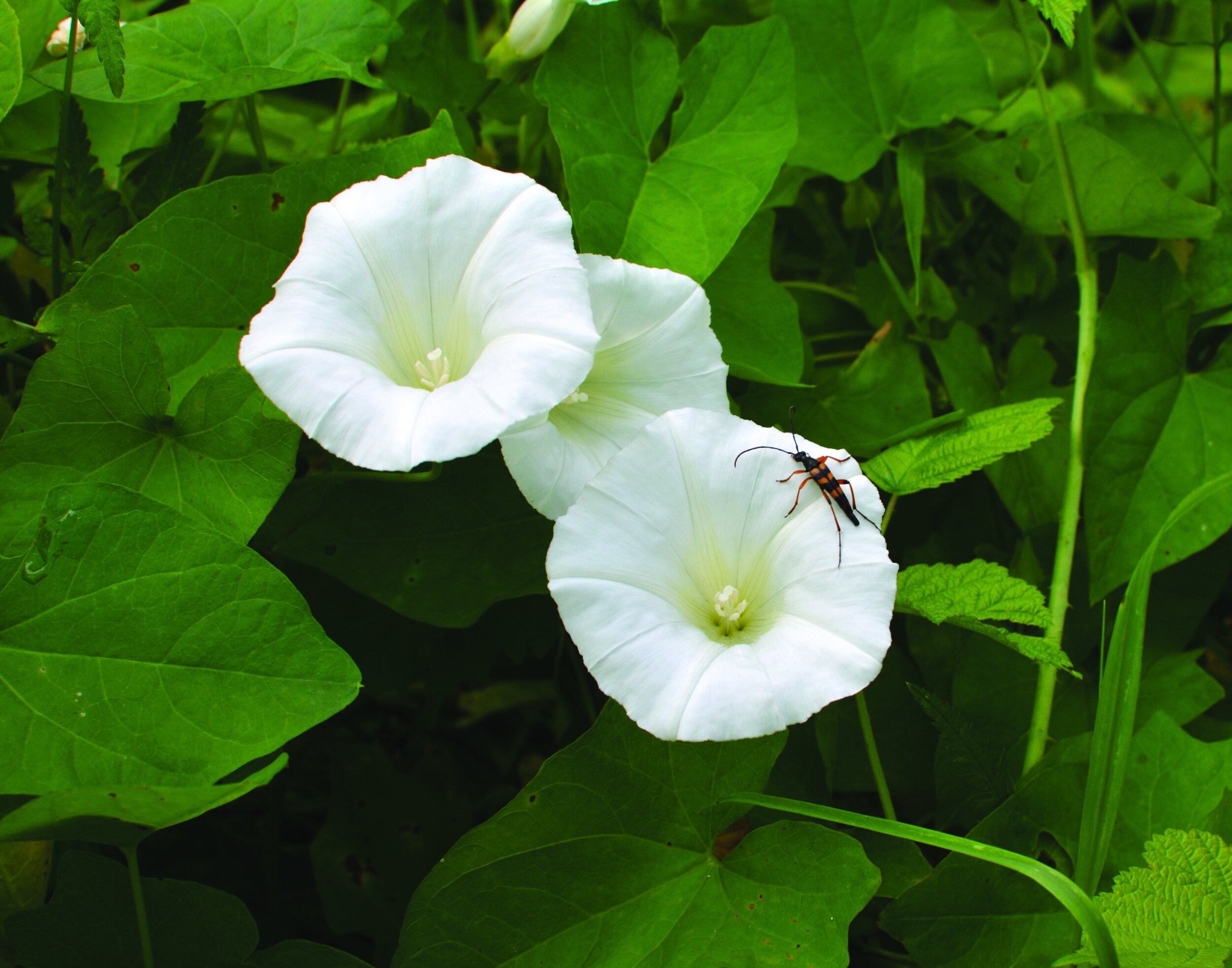In the Weeds: A Meditation
I love early spring. The garden showcases early blooms, asparagus, rhubarb. Weeds are deceptively tiny. Right around April Fool’s Day, I tell myself I’ve got it under control.
For a little while, I forget that eventually the weeds will grow—to twine, stretch, and root as opportunistically as humans do, laying claim to space regardless of who gets pushed out. For a little while, I forget that as a gardener, I tend to bumble about.
I am often in the weeds, without actually doing much weeding.
. . .
Two years ago, in a pandemic-desire to focus on the local and improve myself, I bought Weeds of North America—795 pages, color-illustrated. I felt I would be a better person, or at least a better gardener, if I knew the weeds in my garden—their names, their preferences, their weaknesses, their redeeming qualities, their perils.
I imagined approaching weeds like I do the animals my granddaughter and I study at lunchtime. Every day a different animal that we explore by googling “Fun facts about . . .” We find we can fall in love with almost anyone—certainly the awkward rhino, who charges everything indiscriminately, not out of rage, but just because she can’t see well; yet also the spiky slug moth caterpillar, and the pinkly tentacled star-nosed mole. A few fun facts, and the least appealing animal slips past our defenses.
. . . The Bindweed
I first looked up bindweed, a smothering, slithering morning glory, especially troubling. I now believe I have hedge bindweed, based on the very whiteness of its flowers, the size of its leaves, and its drive to climb up and see the world.
Bindweed seeds can apparently remain viable in soil for up to 50 years. Tiny snips of tiny roots love to start new plants. If you till to get rid of bindweed, the chopped-up roots thank you for your service and sprout with pleasure. My new book calls hedge bindweed “a serious weed.”
Yet it does not appear particularly serious to me—more cheerful in triumph, I would say. It has such a way about it—both abandoned and focused. Overnight, it climbs to the top of a rose bush, screwing itself tightly around the thorny stems, and then pop—the most lovely white trumpet opens up, as if to say—“Me! See me! This rose is nothing—just a handy trellis.” The leaves are fresh, deep green, lush and juicy. Nothing looks as healthy as a mat of bindweed smothering a raspberry bush. No, it doesn’t look serious—it looks like a twenty-year-old who had great sex last night.
There is no Google result for “fun facts about hedge bindweed.” But here is a fun fact I know, from real life: although carefully unwinding it from roses, asparagus, and hydrangeas is tedious, digging up the roots is a perverse pleasure.
I take my favorite garden tool and prick at the base of the plant, then I pull up a root, like pulling up a bobbin thread on a sewing machine. Carefully, slowly, I work the tool down the length of the root as far as I can, lifting it out of the soil, trying not to break it. It weaves its way out from the underground, and I follow. I see the inevitable, tiny, white bits left in the root’s wake. But I have to let them go. I can’t take care of every thread.
My husband has his own technique for discouraging bindweed: he hacks it at the base and leaves the rest to wither on the host plant, kind of the head-on-a-pike approach. This is not my style—I want to look at dead bindweed only slightly more than I want to look at live bindweed.
Yet here is what I am learning about bindweed—my husband is probably right. (It can be irksome when that happens.) The most effective approach is to cut bindweed back, again and again, perhaps for years, weakening it.
Even so, I pursue my own weeding path. Because if bindweed has a redeeming quality for me, it is in my own futile process: if I keep my focus on the long line of root in my hands, if I don’t get distracted by the minute hairs left behind, if I don’t raise my head to see all the adjacent twinings and the white faces trumpeting their glee, my ineffective weeding can be a meditative practice, even if it is Sisyphean. Perhaps because it is Sisyphean.
. . . The Stinging Nettle
Unlike bindweed, it is easy to love the stinging nettle. Stinging nettle populates disturbed ground, but it gives up without much of a fight, its roots loose and light. A plant can live for fifty years, but stinging nettle doesn’t feel invasive. Its most troublesome habitat is in the raspberry patch, because at first glance it might look like the hairy raspberry leaves themselves, and it is so easy to brush against when picking. But other than that, it sticks to the edges—the hedgerow, the corner of the sheep pen, the fence line of the chicken run, the north edge of the shop.
Its admirable qualities, a mix of established folk medicine and scientific study, are many. Nettles, carefully prepared to eliminate the sting, are nutritionally rich, and they can be effective against hay fever.
They make lovely soup—green and earthy. Perhaps their kindest quality is their early arrival—the first spring harvest, always ready by the equinox. The March that Covid took root, I took comfort in the sprouting nettle. Here were fresh greens, ours for the picking.
But they are a weed as well—and they have traits that make them feel weedy to some, if weedy means unwanted. Their abundant hairs leave a morning sting that can be felt well into the evening and even the next day. I don’t mind the stings in small doses, having read years ago that nettle sting might counteract arthritis. As with the bitter taste of goldenseal, I now associate a quick brush against nettle with healing.
Less appealing, as they age, nettles get more tattered and smell unhappily of cat urine. In their bedraggled phase, they seem less medicinal and more capable of lashing out with a quick bite, just waiting to ambush a small grandchild going out to feed the sheep. If you are four years old, and have no need to counter arthritis, the sting is just mean.
Still, I have made my peace with nettle. I know what it has to offer. Even Weeds of North America, often alarming, is complacent about the stinging nettle, declaring it of “little economic importance,” which means it rarely gets in the way of human profit.
. . .The Thistle
Like nettle, thistle loves the sheep pen. But thistle bristles hurt more deeply than nettle sting. Thistle has a fluffy purple flower, smaller than but similar to its benevolent cousin, the artichoke. According to some sources, thistle parts are edible—their peeled stalks are even described as “delicious,” but I know no one who eats it. My sheep have certainly not gotten the message; like me, they are deterred by the thistle spines.
Thistle is hard to eradicate, it spreads widely, wildly through its root system. We can mow much of the pasture to help control it, but mowing must be frequent, and the edges are harder to reach. Each plant can let loose 1,200 seeds; each seed can live 21 years.
When I weed thistle, my goal is to keep it from blooming. I start out mindfully, especially of the ache in my left lower back that does not like me to bend over too much, and certainly does not like me to tug. But after a while, mindfulness fades, and I am ripping, scraping, and bending, a pile of thistle growing. When I’m done, I can’t figure out if I like what I have better than what I had: the short, spiky stalks still standing, the pile of dying vegetation, the disrupted look that I don’t have energy to smooth over. At least, I tell myself, I can get to the barn door without threat.
Reading Weeds of North America, I feel fairly confident we have Canada thistle. According to the Skagit County weed criminal code, Canada thistle is a Class C problem, far from desirable, but not as unwanted as the milk thistle, a Class A felon.
Eventually, I google “eradicating thistle”. The common solution, it seems, is glysophate, also known as Round-Up, widely used, and widely implicated in harm to both humans and amphibians. Ahh. Yes. Perhaps it is a matter of preference. Mine is for the frog song in the evening.
. . .
Three plants in, and I have barely scratched the surface of my weedy ground. There are hundreds of pages left in Weeds of North America. I am left with many questions: why, for example, do I prefer the flowers I plant to the ones which cheerfully volunteer to grow? Or, even more perplexing, why do I weed and discard dandelions on a Wednesday, and then buy dandelion tea in a box on Thursday?
The one thing I can safely say is that I’m becoming more philosophical about my lack of control. 1,200 seeds, indeed. And I’m learning, too, that a weedy garden is fertile ground for meditation.



